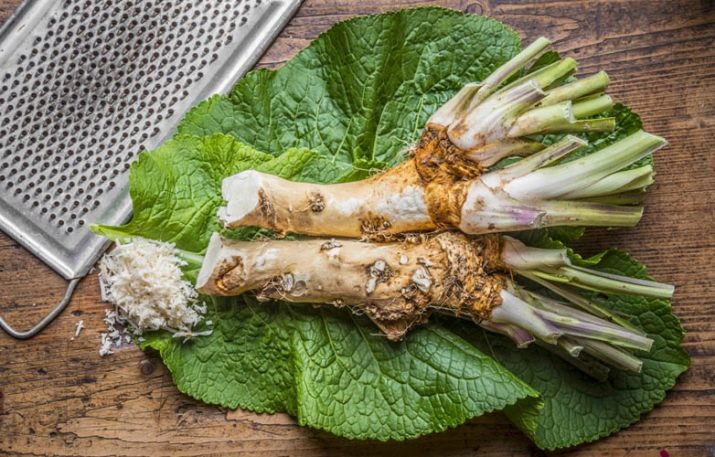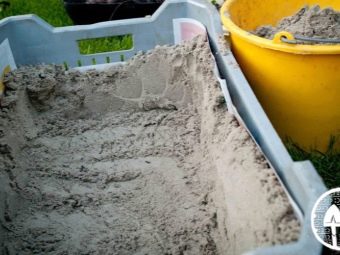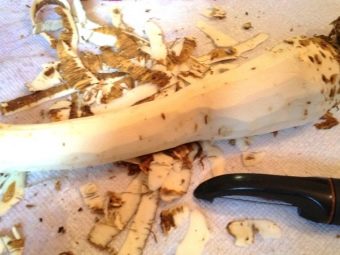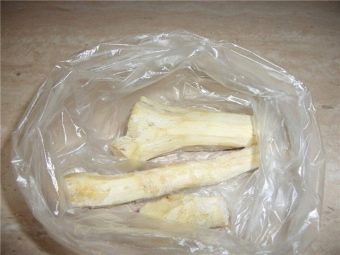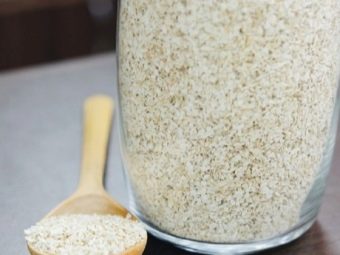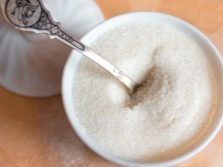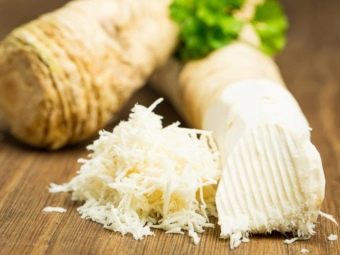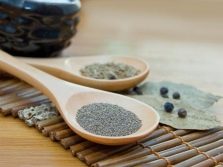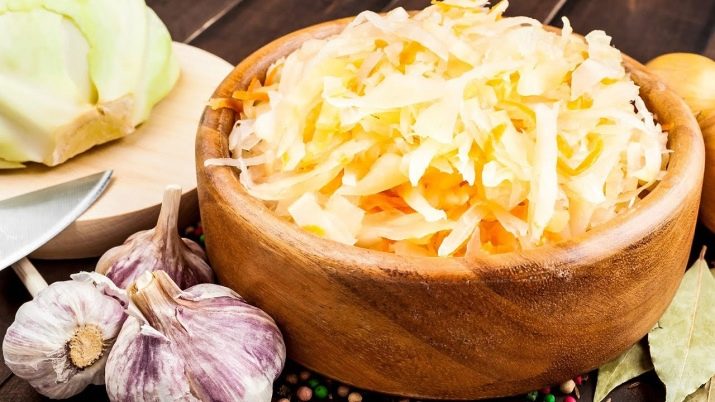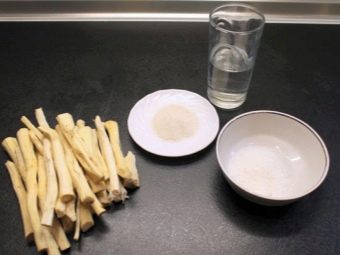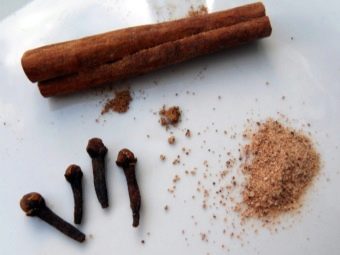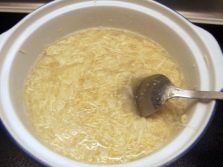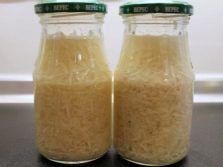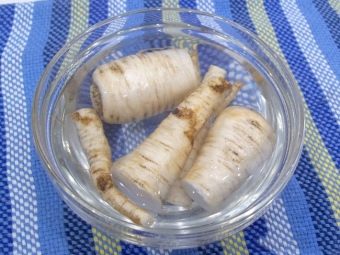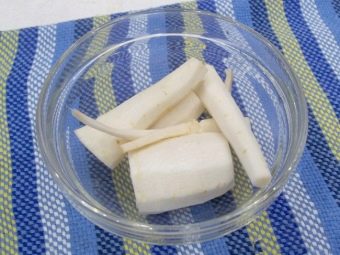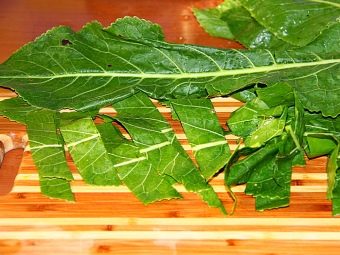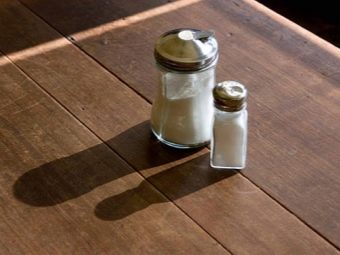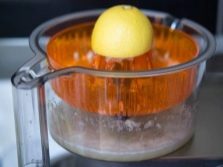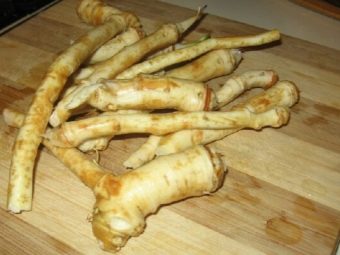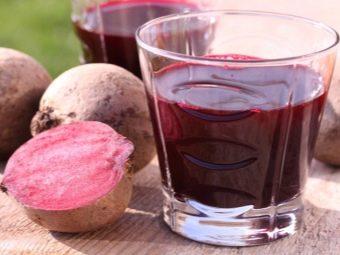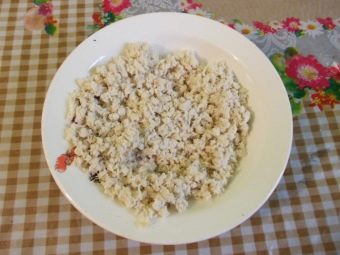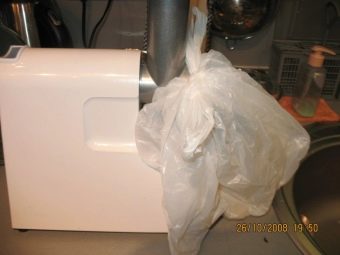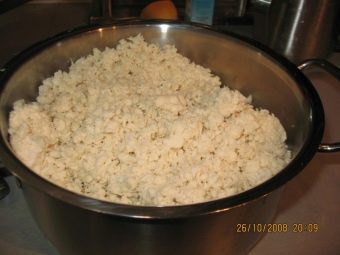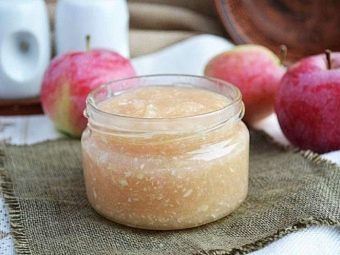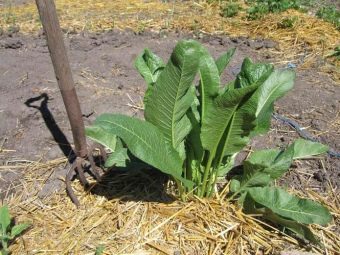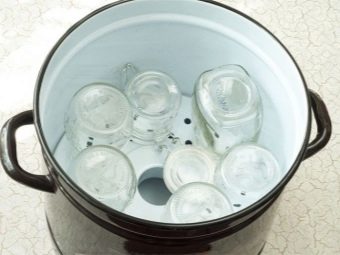Recipes delicious horseradish for the winter
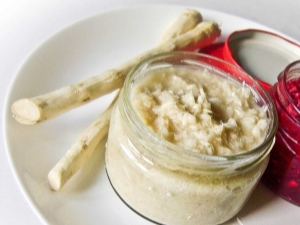
It is impossible to overestimate the role of horseradish in home canning. Rhizomes and dried leaves give pickled foods a special sharp taste and piquancy.Experienced housewives prefer not only to add seasoning to jars of vegetables, but also to harvest it for the winter. Seasonings and horseradish sauces will not only complement meat, fish dishes, but also help strengthen the immune system, which is especially important during the winter cold. Since there are practically no useful substances in the purchase jars with the product, harvesting a fresh product at home is particularly relevant.
Beneficial features
Horseradish takes a leading place among the means of traditional medicine. The use of seasoning preparations will help support the body in the difficult winter period.
The beneficial properties of horseradish are manifold.
- The product is used to prevent colds. Promotes the removal of sputum from the body.
- It protects the body from infectious diseases due to the presence of volatile in the composition. Because of this property horseradish is considered a natural antibiotic.
- Seasoning is recommended to use in small quantities with diabetes because it helps to normalize the level of glucose in the blood.
- Horseradish improves appetite, stimulates stomach peristalsis. For this reason, it is served with fatty and heavy foods. It also improves the functioning of the gastrointestinal tract as a whole. Helps with constipation.
- Promotes the removal of bile from the body.
- It has a diuretic effect. Horseradish eliminates foci of inflammation in the urinary tract, treats cystitis and dropsy, helps get rid of kidney stones. Doctors often recommend seasoning as a supplement to basic medical treatment.
- Favorably affects the teeth, protects the enamel from destruction.
- The use of horseradish can improve male potency.
- Helps in the fight against excess weight. Low calorie product (65 kcal per 100 g) in combination with stimulation of metabolism makes it almost indispensable during the diet.
Billet horseradish helps fight neuralgia, arthritis, rheumatism, promote healing of the skin.
Doctors recommend to use seasoning with low blood pressure. As part of horseradish a lot of ascorbic acid, so it has a positive effect on the immune system and helps to overcome the symptoms of beriberi. The beneficial properties of horseradish go beyond culinary use. So, the grated plant can be used as a compress for radiculitis and cold.
Only homemade preparations with horseradish have such a list of useful properties. Canned horseradish from the store can only improve the taste of the dish. In production conditions, seasoning is processed in such a way that all the useful elements perish.
Contraindications
An impressive list of useful properties does not make horseradish a universal remedy. Oddly enough, it is worth refusing spicy seasoning for diseases of the liver, kidneys and gastrointestinal tract. Doctors prohibit the use of horseradish children and women during pregnancy, lactation. To use the product in large quantities is not worth it and healthy people: it can cause internal bleeding, burns of mucous membranes, increased blood pressure.
Doctors also recommend completely abandon horseradish in such cases:
- when using drugs containing chloramphenicol: the presence of antimicrobial components in the composition of horseradish interferes with the action of such drugs;
- Horseradish increases the level of acidity and irritates the intestinal wall, the stomach, so you can not eat it for ulcers and gastritis;
- seasoning stimulates blood circulation, so women should give up it during menstruation;
- categorically contraindicated use of dishes with horseradish in the presence of problems with the kidneys and liver.
Storage methods
Rhizomes are used for medicinal purposes and begin to harvest in the fall. You can save seasoning before winter in different conditions. It all depends on your capabilities and preferences. Consider the best options.
In the basement
If you have a cellar or basement, then you can easily store the seasoned there.To begin, clean and dry the roots of horseradish in the open air. Prepare a wooden box, sprinkle the bottom with high-quality sand. Lay the roots in even rows, sanding between them. Each rhizome should be separated and be sprinkled with sand from all sides.
In a more modern version, you can use the box of foam and store it on the balcony. It is important to maintain the moisture of the sand.
To do this, it is enough to spray it with water every 7–10 days.
In a refrigerator
In this case, the roots are stored at a positive temperature, which means that they need to be prepared in a special way. Rinse the rhizomes well with running water, remove the skin with a knife. Dry in the open air for 2 days. Cut horseradish into 4–5 cm pieces.
In order to keep the seasoning until the end of winter, you need to take care of hermetic packaging. It is important to put each root in a separate package. You can use special packaging or solder plastic bags.
In the freezer
Horseradish can be frozen in different ways. You can cut the seasoning into portions, put them into packets and send them in the freezer. In winter, it is enough to get one of them and cook in any way. Another option - immediately chop the roots or even mix with something. With this storage, simply defrost the package, and the seasoning is ready for use.
In dried form
Cut the washed and dried roots into convenient pieces and dry using the oven, dryer for vegetables. It is considered more traditional to dry in the open air in the shadow zone. After drying, be sure to chop the pieces with a coffee grinder or blender. Transfer the resulting crumb into a tight-fitting container in order to preserve the flavor of the seasoning. If desired, you can store and dry pieces of roots, then pack them in cotton bags.
Such horseradish is not intended for the preparation of traditional seasonings, but its use is quite wide. You can add dried spice to soup, salad, sauce, and similar dishes. This horseradish can be mixed with other seasonings and used in the preparation of meat, fish.
Cooking options
The most interesting - horseradish recipes for the winter. You can prepare a lot of seasonings and sauces with this ingredient, put the dish in airtight containers and store in the refrigerator for quite some time.
Horseradish with sour cream
The easiest way to cook horseradish with sour cream. To do this, just rub 150 g of the product and mix with 100 g of sour cream and 0.5 tsp. Sahara. Sauce combines piquancy and tenderness.
If in the same recipe you replace sour cream with fat cream and add grated almonds, you will get a more piquant version of the sauce. It goes well with vegetables, meat and fish.
Hrenadier
Hot lovers should cook hrenadier. To do this, mix 100 g of grated horseradish, 2 crushed garlic cloves and 2 tomatoes, pre-chopped in a meat grinder.
If desired, add salt and ground pepper.
Hungarian horseradish
Hungarian horseradish beetroot preparing a little more difficult. It is necessary to boil 4 beets and grate with 2 large horseradish roots. Next, add 2 tsp. sugar and the same vinegar, salt, pepper and cumin to taste. This dish must be left for a few hours so that it is infused. Hungarian horseradish goes well with smoked meats, meat and kebab of pork, veal.
Sauerkraut with horseradish
The most popular recipe among hostesses. Chop 5 forks of cabbage and rub 3 medium-sized carrots. Divide one root of horseradish in half: rub one part and cut another. Rub the enameled bowl with grated horseradish, mix the rest of horseradish with cabbage, carrots, dill branches, salt (5 tbsp), bay leaves (3 pcs.), Black pepper (5 tsp) in another bowl.
Transfer the whole mixture into a container, rubbed with horseradish, well tamping as needed. Cover the pan with gauze, press down with a plate and place the load on top. For this it is convenient to use a large jar of water.Leave the cabbage with horseradish in a warm place for 3-4 weeks, after the expiration date, you can enjoy the dish.
There are other ways to make a supply of horseradish for the winter. You can marinate, preserve or freeze the product for a long period. Golden recipes conquer the hearts of not only young but also experienced housewives due to their simplicity and delicious taste. Each method retains the maximum amount of nutrients in the seasoning.
Marinated
Keep the workpiece on the balcony or in another cold place. The recipe below involves the use of horseradish without additions, but you can mix 1 part rhizome with 2 parts beet. Marinated seasoning will always be at hand at the right moment.
You will need the following ingredients:
- fresh horseradish roots - 1 kg;
- water - 1 cup;
- salt, sugar - 1 tbsp. l .;
- juice of one lemon;
- cinnamon, ground nutmeg - 1 pinch each;
- Clove buds - 2–3 pcs .;
- mustard seeds - 0, 25 tsp.
To make the seasoning really spicy, you must strictly follow the sequence of actions when cooking.
- Peel off the roots and cover with cold water. Let stand for 30 minutes.
- Using a grater, blender or grinder, recycle the roots of the plant.
- Boil water with sugar, salt, lemon juice and all seasonings, cool and strain the liquid through a fine sieve or gauze.
- Mix the prepared horseradish with purified brine. Spread over small sterilized jars.
- Cover containers with lids, put in boiling water for 20 minutes for additional purification.
Roll up the banks and wait for complete cooling.
Frozen
The best way to keep horseradish fresh. You can freeze the product whole or in ground form. Experienced housewives assure that as a result of such storage the taste and smell of horseradish become more vivid and rich. It can be thawed and used in all recipes where a fresh product is needed.
Leaves and rhizome of horseradish can be stored in the freezer for about 12 months. The main condition - the temperature should not exceed –18 degrees during the entire period. In case of drops, the shelf life is reduced to 8–10 months.
Before packing, be sure to thoroughly clean the horseradish of dirt and skin. To facilitate this process, you can fill the product with water for 2-4 hours. Place the cleaned pieces immediately in a container of cold water to minimize contact with air. So all flavors will remain. Then dry the roots in the open air or with paper towels.
If you decide to pack the whole pieces, then cut the roots into pieces 3 cm long. Put them in an airtight container or bag. Grated horseradish store more convenient. For grinding it is better to use a blender or meat grinder. When processing the roots with a grater, aromatic substances will evaporate and disturb you.
You can freeze the product immediately in the form of a finished dish, it is very convenient and will significantly save your time when you decide to use the preform. You can combine grated apples with horseradish in a 1: 1 ratio and add 1 tsp. lemon juice. Snacks can be frozen in packages or in ice forms. In the second case, wait until complete freezing and move the cubes into a container package.
In winter, you may need not only roots, but also horseradish leaves. Before freezing, just rinse them under running water and dry in any convenient way. Divide the total amount into convenient portions, arrange into special sealed bags. Leaves do not need to be thawed before use.
Canned
It is quite convenient to harvest the seasoning in canned form. It is important to note that this method does not make it possible to retain all the beneficial trace elements in the composition of the product.
The special spicy taste and captivating flavor remain as strong as with other cooking methods.
Traditional recipe
The traditional recipe does not take much of your time.
For the preparation of blanks without additional flavors will need the following ingredients:
- fresh horseradish roots - 1 kg;
- water - 1 cup;
- vinegar solution - 150 ml;
- salt, sugar - 1 tbsp. l
The method of preparation under the force of any hostess.
- Clean the horseradish from dirt and skins, cut into 2-3 pieces. Fill with cold water and leave in a dark place for 40 minutes. These actions will simplify further processing and make horseradish more juicy.
- Rub, twist or perebite blender horseradish roots.
- To prepare the brine, you must put water on the fire and put salt with sugar. Bring the liquid to a boil, add the vinegar solution.
- Cool the water, add to it horseradish.
- Put the mixture in sterilized jars.
Without sterilization
There is a faster and simpler method of canning root vegetables, time is saved due to the lack of sterilization of cans. There is no vinegar in the recipe, so horseradish retains a greater amount of useful substances. You can store jars in any cool place.
Ingredients:
- fresh horseradish roots - 1 kg;
- water;
- salt, sugar - 2 tbsp. l .;
- citric acid - 2 bags.
It is so easy to make such a blank that even an inexperienced hostess can easily cope with it.
- Soak clean roots in cool water for 20 minutes. Crush horseradish.
- Add granulated sugar and salt to the shredded mass.
- Pour boiling water into a container with horseradish.
- Spread the finished product into sterile cans.
- Add 1 tsp. citric acid in each jar immediately before seaming.
With lemon
An interesting method of preparation - a recipe with lemon. Such preservation will be an excellent addition to fish dishes on a winter day. In the future, you can mix the contents of a can with sour cream or cream and get a delicious sauce in just 5 minutes. Moreover, horseradish for this recipe retains the ability to strengthen the immune system and fight colds.
You will need this list of ingredients:
- horseradish roots - 1 kg;
- large lemon - 1 pc .;
- water;
- salt, sugar - 1 tbsp. l
An effective means of improving health is also easy to prepare.
- Soak peeled root vegetables in cold water for half an hour.
- Crush horseradish in any convenient way. Add salt and sugar to the horseradish mass.
- Lemon boil the lemon. Remove the skin and squeeze the juice.
- Add the zest to horseradish.
- Boil water and cool to room temperature.
- Mix horseradish gruel with water and pour the thick mixture into sterile jars.
- In each container, pour 1 tsp. lemon juice and close tightly.
With beet juice
If you want to make something more interesting, then the recipe for seasoning with beet juice is perfect for you. Such preservation can be immediately laid out on plates - no need to mix with other ingredients.
It goes well with meat.
Ingredients:
- horseradish root - 1 kg;
- salt - 1 tbsp. l .;
- sugar - 2 tbsp. l .;
- beet juice - 500 ml;
- Vinegar 70% - 30 ml.
You will need about 1 hour to prepare.
- Beet juice mixed with sugar and salt. Bring to a boil.
- Cool the liquid to room temperature. Add vinegar.
- Rub the peeled horseradish root and mix with beet juice.
- Pour mixture into hermetic containers.
Tips
Horseradish is used for preparations for the winter at home in different ways. To ensure that any twist is not soured or moldy, you can simply put the crushed dried leaves of the plant on top. Also, the product will help keep tomatoes and cucumbers fresh for 3 months. To do this, put 200 g of ground seasoning on the bottom of the jar (3 liters) and cover with cardboard with holes. Put vegetables on top and keep in a cool place.
When processing horseradish tears are often welling. There are excellent folk methods that will help avoid this unpleasant phenomenon. Take an ordinary meat grinder and put a simple plastic bag on the way out. Put the twisted horseradish out of the bag into the container in which you continue to prepare the blank.In order to grate horseradish a lot faster, just freeze it.
If the roots themselves have lost their former freshness, the situation is easily remedied. Just soak the horseradish in ice water for 24 hours. By the way, after that it will be much easier to peel it. The cleaning process itself is best done with rubber gloves. Otherwise, you can get light chemical burns.
While cooking their horseradish seasonings for the winter, it is very important to use only glass containers that can be sealed with lids. A simple trick will help to preserve the special aroma and savory taste of seasoning for a long time. Moreover, it is better to use small cans. Essential oils very quickly disappear from horseradish, so it is important to use the contents of an open can in 3-4 days.
If later you want to slightly soften the taste of preservation, then simply mix it with fat sour cream or thick cream.
All recipes for horseradish preparations for the winter seem very simple and do not require much time.
There are special tricks that experienced housewives use to make delicious seasonings.
- Harvest horseradish for culinary purposes in September. Select roots 30–50 cm long and 3–6 cm in diameter.
- Do not make a large number of twists. It is necessary to eat the seasoning in the coming winter, otherwise it will lose its sharpness and piquancy.
- Fresh root without mechanical damage can be stored in the refrigerator for up to 6 months. You can use it as needed. If horseradish has slices, but in 4–5 days it will lose its taste.
- After you take the root out of the garden bed, it gradually begins to lose moisture. Before you start cooking seasoning, be sure to soak the product for several hours to restore the deficit.
- The sterilization process is very important in preparation for rolling horseradish and seasoning with its use. Never neglect this stage, otherwise the workpiece will quickly deteriorate.
- The easiest way to process the roots of horseradish in a blender with a closed bowl. So you will not feel the influence of vapors on the mucous membranes. If you use a grater, then pre-freeze the product, then the essential oils will be released less actively.
- It often happens that the root of horseradish in a processed form begins to lose its former color. To avoid this is quite simple - sprinkle the billet with freshly squeezed lemon juice.
- To prepare a really hot seasoning, stop using vinegar. The sour taste of the component completely distorts the taste of the sharp root of horseradish.
Previously, horseradish served to the table immediately after preparation, to convey to guests all the sharpness of the dish. To date, the hostesses have in their arsenal a lot of ways to preserve this particular seasoning for a long time. Ready preservation can be opened in the winter and used as a sauce for snacks, meat and fish dishes. If desired, you can add horseradish with sour cream in a vegetable salad to give a more interesting flavor.
Next, see the video recipe of cooking crap for the winter.

